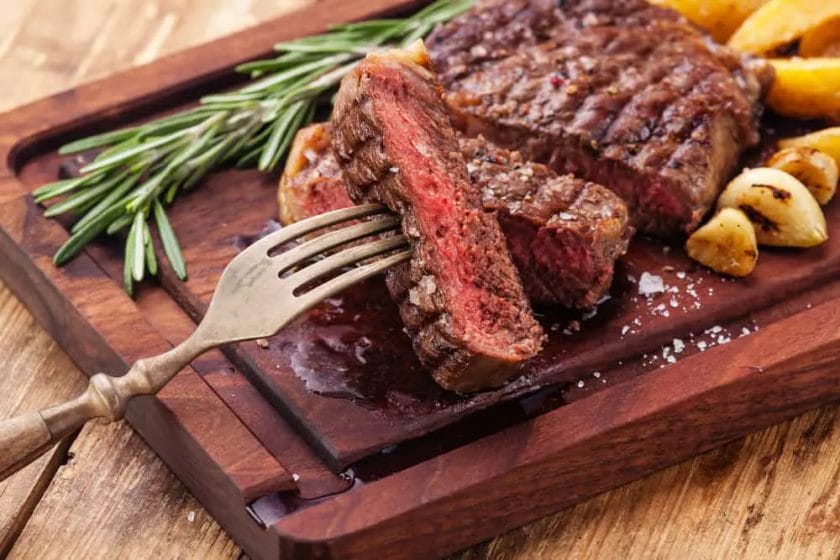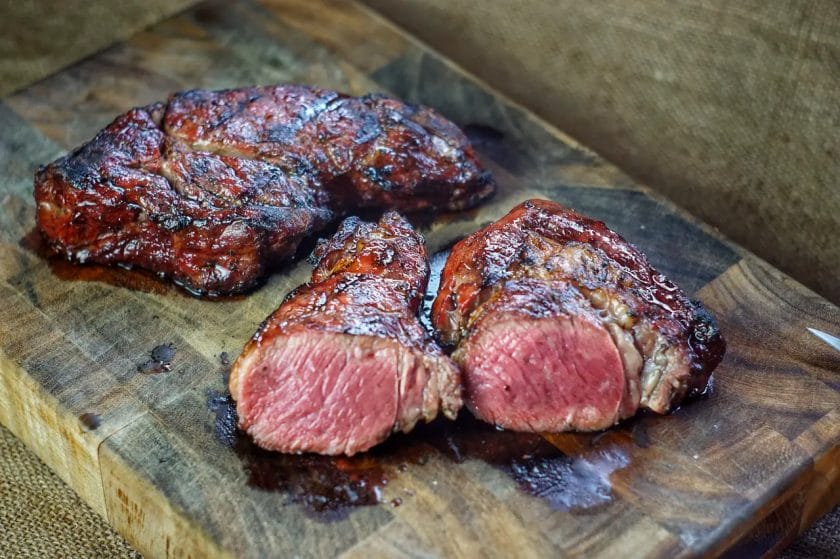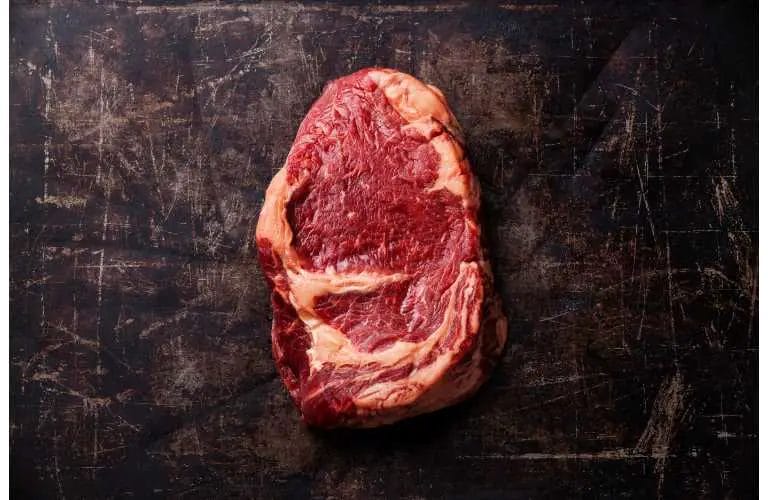If you’ve ever experienced a tough ribeye steak, you might be wondering why this juicy cut can sometimes disappoint. The tenderness of a ribeye steak is influenced by several factors, including the quality of the meat, the cooking method, and the cut’s marbling.
Marbling refers to the intramuscular fat that runs through the meat, providing flavor and tenderness. Skipping proper resting time after cooking, overcooking, or using incorrect temperatures can also contribute to a tough ribeye steak.
Understanding these factors can help you achieve a perfectly tender and flavorful ribeye steak every time.

Overcooking Ribeye Steaks: The Main Culprit Behind Tough Meat
When it comes to cooking a perfect ribeye steak, one of the biggest mistakes that can be made is overcooking it. Whether you’re grilling, pan-searing, or broiling, overcooking can result in a tough, chewy, and less flavorful piece of meat.
In this section, we will explore why overcooking ribeye steaks leads to tough meat and how you can avoid this common culinary mishap.
One of the key factors that contribute to the tenderness and juiciness of a ribeye steak is the marbling – the small streaks of fat throughout the meat.
When a ribeye steak is cooked to the perfect temperature, the fat melts, infusing the meat with flavor and moisture. However, when the steak is overcooked, the fat renders out completely, leaving behind dry and tough meat.
Overcooking a ribeye steak also affects the proteins in the meat. When the steak is subjected to high heat for an extended period, the proteins begin to denature and contract, resulting in a firm and rubbery texture.
This is why it’s important to cook ribeye steaks to the recommended internal temperature to ensure a tender and juicy result.
So, how can you avoid overcooking your ribeye steak and ensure a perfect dining experience? Here are a few tips:
1. Use a Meat Thermometer
Investing in a good quality meat thermometer is a game-changer when it comes to cooking steaks.
It allows you to accurately monitor the internal temperature of the meat and ensure that it reaches the desired level of doneness. For a medium-rare ribeye steak, aim for an internal temperature of around 130°F to 135°F.
2. Rest the Steak
After cooking your ribeye steak, it’s crucial to let it rest before slicing into it. Resting allows the juices to redistribute throughout the meat, resulting in a more flavorful and tender steak. Simply tent the cooked steak with foil and let it rest for about 5 to 10 minutes before serving.
3. Practice the Touch Test
If you don’t have a meat thermometer on hand, you can rely on the touch test to determine the doneness of your ribeye steak. Using the palm of your hand as a reference, compare the firmness of the steak to different parts of your hand.
As the steak cooks, it will gradually become firmer. For a medium-rare steak, it should feel like the base of your thumb when you touch your thumb and index finger together.
4. Opt for Reverse Sear Method
The reverse sear method is a popular technique for cooking ribeye steaks to perfection.
It involves slowly cooking the steak at a low temperature in the oven, then finishing it off with a quick sear on a hot pan or grill to achieve a delicious crust. This method ensures even cooking and reduces the risk of overcooking the steak.
By following these tips and being mindful of the cooking time and temperature, you can avoid the common pitfall of overcooking ribeye steaks and enjoy a tender, juicy, and flavorful dining experience every time.
Remember, a perfectly cooked ribeye steak is all about finding that sweet spot between juicy and deliciously charred!
Understanding the Importance of Proper Resting Time for Ribeye Steaks
When it comes to cooking a perfect ribeye steak, many people focus solely on the cooking process itself, neglecting an equally important step – resting the steak.
Resting time refers to the period after the steak is removed from the heat source and allows the meat to relax and redistribute its juices. While it may seem like an insignificant step, resting a ribeye steak has a significant impact on its final taste and tenderness.
The Science Behind Resting
Resting a ribeye steak is not just a culinary tradition; it is backed by science. When the steak is exposed to high heat during cooking, the muscle fibers contract, causing the juices to move towards the center of the meat.
Resting allows these juices to redistribute evenly throughout the steak, resulting in a more flavorful and tender bite.
Additionally, resting allows the temperature of the steak to even out. During cooking, the outer layer of the steak becomes significantly hotter than the center. Resting the steak helps the heat to distribute evenly, preventing a stark contrast in temperature between the exterior and interior of the meat.
Recommended Resting Time
The proper resting time for a ribeye steak depends on its thickness. As a general rule of thumb, a steak should rest for about 5 minutes per inch of thickness.
This means that a 1-inch thick ribeye steak should rest for approximately 5 minutes, while a 2-inch thick steak may require around 10 minutes of resting time.
During the resting period, it is essential to keep the steak warm. You can cover it loosely with aluminum foil to retain some of the heat. However, avoid wrapping it too tightly, as this can cause the steak to steam and lose some of its crispiness.
The Benefits of Resting
Resting a ribeye steak provides a myriad of benefits that significantly enhance its overall quality.
1. Improved Texture
Resting allows the steak to relax and become more tender. The redistribution of juices helps to moisten the meat evenly, resulting in a delightful buttery texture.
2. Enhanced Flavor
By allowing the juices to distribute evenly, resting ensures that each bite of the ribeye steak is packed with flavor. The combination of the steak’s natural juices and any additional seasonings permeates throughout the meat, creating a more palatable and enjoyable eating experience.
3. Temperature Evenness
Resting allows the temperature of the steak to equalize, ensuring that the center is not drastically different from the outer layers. This prevents a temperature shock when slicing into the steak, resulting in a more consistent doneness throughout.
4. Juiciness
When a ribeye steak is cooked, the heat causes the proteins to contract and squeeze out some of the moisture. Resting helps the meat retain these juices, ensuring that each bite is succulent and juicy.
In summary, proper resting time is a critical step in achieving the perfect ribeye steak. By allowing the steak to rest after cooking, you ensure that it is tender, flavorful, and evenly cooked. So, the next time you grill a mouthwatering ribeye, remember to factor in the resting time for an exceptional dining experience.
3. Marinating Techniques: Enhancing Tenderness in Ribeye Steaks
In this section, we will explore various marinating techniques that can enhance the tenderness of ribeye steaks. Marinating is the process of soaking meat in a flavored liquid to enhance its flavor, tenderness, and juiciness.
When it comes to ribeye steaks, marinating can help break down the tough connective tissues and add extra flavor to the meat.
1. Acidic Marinades
One popular marinating technique is using acidic marinades. Acidic ingredients such as citrus juices (lemon, lime, or orange), vinegar, or wine help tenderize the meat by breaking down the muscle fibers.
The acid in the marinade helps to denature the proteins, resulting in a more tender steak. Additionally, acidic marinades can add a tangy and refreshing flavor to the meat.
When using acidic marinades, it is important not to over-marinate the ribeye steak. Leaving the steak in an acidic marinade for too long can make it mushy and affect the texture negatively. It is recommended to marinate the steak for about 2 to 4 hours, depending on the thickness of the cut.
2. Enzymatic Marinades
Enzymatic marinades are another effective technique for enhancing the tenderness of ribeye steaks. These marinades contain ingredients that naturally contain enzymes, such as pineapple, papaya, or ginger.
These enzymes break down the tough connective tissues in the meat, resulting in a more tender steak.
It is important to note that enzymatic marinades work quickly, so it is best to marinate the steak for only 30 minutes to an hour. Leaving the steak in an enzymatic marinade for too long can lead to over-tenderization and affect the texture negatively.
3. Oil-Based Marinades
Oil-based marinades are a popular choice for marinating ribeye steaks. These marinades consist of oil, herbs, spices, and other flavorings. The oil in the marinade helps to keep the steak moist and adds richness to the flavor. Additionally, the herbs and spices in the marinade infuse the meat with aromatic flavors.
When using oil-based marinades, it is important to allow the ribeye steak to marinate for at least 2 hours, or even overnight. This allows the flavors to penetrate the meat fully and enhances the overall taste and tenderness of the steak.
4. Combination Marinades
Combination marinades involve using a combination of acid, enzymes, and oil-based marinades to maximize the tenderness and flavor of the ribeye steak.
These marinades often include ingredients like wine or citrus juice for acidity, pineapple or papaya for enzymatic tenderization, and oil, herbs, and spices for additional flavor.
The combination marinade technique allows for a more well-rounded and complex flavor profile while tenderizing the meat. It is essential to follow the recommended marinating times for each ingredient to avoid over-marinating and affecting the texture of the steak.
Summary
Marinating ribeye steaks can greatly enhance their tenderness and flavor. Acidic marinades, enzymatic marinades, oil-based marinades, and combination marinades are all effective techniques to achieve a more tender and flavorful steak.
It is important to marinate for the recommended time, depending on the marinade used, to avoid over-marinating and affecting the texture negatively. With the right marinating technique, you can elevate your ribeye steak to a whole new level of deliciousness.
Choosing the Right Grade and Cut of Ribeye for Maximum Tenderness
When it comes to indulging in a juicy and flavorful steak, a ribeye is often the cut of choice for many meat lovers. Known for its marbling and tenderness, the ribeye offers a melt-in-your-mouth experience that is hard to resist.
However, not all ribeyes are created equal. To ensure maximum tenderness and flavor, it is important to choose the right grade and cut of ribeye. In this section, we will explore the factors to consider when selecting a ribeye steak.
1. Grade of Ribeye
The grade of the ribeye is an important factor in determining its tenderness and overall quality. The United States Department of Agriculture (USDA) grades beef based on several factors, including marbling, maturity, and color. The three most common grades of ribeye are Prime, Choice, and Select:
- Prime: This is the highest grade of beef and is known for its exceptional marbling, tenderness, and flavor. Prime ribeye steaks are typically found in high-end steakhouses and gourmet meat markets.
- Choice: Choice ribeyes also have a good amount of marbling and offer a tender and flavorful eating experience. They are more widely available and can be found in most grocery stores.
- Select: Select ribeyes have less marbling and tend to be leaner, resulting in a slightly less tender and less flavorful steak. They are a budget-friendly option but may require additional cooking techniques to enhance tenderness.
2. Cut of Ribeye
The cut of ribeye refers to the specific portion of the rib primal from which the steak is derived. Here are some popular cuts of ribeye:
- Bone-In Ribeye: Also known as a cowboy steak, this cut is prized for its exceptional flavor and juiciness. The bone adds extra flavor to the meat during cooking.
- Boneless Ribeye: This cut is more convenient to eat and offers the same great taste and tenderness as the bone-in ribeye.
- Tomahawk Ribeye: This cut is a bone-in ribeye with an elongated bone, resembling a tomahawk axe. It is visually appealing and makes for an impressive presentation.
- Ribeye Cap: Also known as the deckle or spinalis dorsi, this highly desirable cut comes from the outer edge of the ribeye and is known for its intense marbling and tenderness.
3. Consideration of Personal Preferences
While the grade and cut of ribeye play a significant role in determining tenderness, it is also essential to consider personal preferences.
Some individuals prefer a fattier steak with abundant marbling for extra flavor, while others may opt for a leaner cut. It is advisable to consider both the grade and cut of ribeye that align with your taste preferences.
In summary, choosing the right grade and cut of ribeye is crucial for achieving maximum tenderness and flavor. The grade of ribeye, whether it is Prime, Choice, or Select, will determine the level of marbling and overall quality.
Additionally, the cut of ribeye, such as bone-in, boneless, tomahawk, or ribeye cap, will offer different flavor profiles and presentation options. By considering personal preferences along with the grade and cut, you can select the perfect ribeye steak for a truly exceptional dining experience.
Tenderizing Methods: Unlocking the Juiciness of Ribeye Steaks
When it comes to cooking a delicious ribeye steak, tenderizing the meat is key to unlocking its full potential. Tenderizing helps break down the tough connective tissues in the meat, resulting in a flavorful and juicy steak.
In this section, we will explore different tenderizing methods that will elevate your ribeye steak game.
1. Marinating
Marinating is a popular tenderizing method that involves soaking the steak in a mixture of acid-based ingredients, such as vinegar, citrus juice, or wine. The acid helps to break down the muscle fibers, resulting in a more tender and flavorful steak.
To marinate a ribeye steak, simply prepare a marinade of your choice, place the steak in a resealable bag, pour the marinade over it, and refrigerate for at least 2 hours or overnight for maximum tenderness. Remember to discard the marinade before cooking the steak.
2. Using a Meat Tenderizer
If you prefer a hands-on approach, using a meat tenderizer can help tenderize the ribeye steak. A meat tenderizer is a kitchen tool with small, sharp blades or spikes that help break down the muscle fibers.
To use a meat tenderizer, simply press and roll it across the surface of the steak, focusing on the tougher areas. Be careful not to over-tenderize the steak, as it can become mushy. This method is great for thinner cuts of ribeye steak.
3. Salt Brining
Salt brining is a technique commonly used to tenderize and flavor meats. It involves soaking the steak in a saltwater solution, which helps to draw out moisture, break down proteins, and relax the muscle fibers.
To salt brine a ribeye steak, dissolve salt in water until it reaches a ratio of 1 tablespoon of salt per cup of water. Submerge the steak in the brine for about 1 hour per inch of thickness, then rinse and pat dry before cooking.
4. Mechanical Tenderization
For tougher cuts of ribeye steak, mechanical tenderization can be a game-changer. This method involves using a meat mallet or a meat tenderizing machine to physically break down the muscle fibers.
To mechanically tenderize a steak, place it on a sturdy surface, cover it with plastic wrap, and use the flat side of a meat mallet to pound the steak evenly until it reaches the desired thickness. Alternatively, a meat tenderizing machine uses small blades or needles to achieve the same result.
5. Enzyme-based Tenderizers
Enzyme-based tenderizers, such as papain from papaya or bromelain from pineapple, can be used to naturally tenderize ribeye steaks. These enzymes break down proteins in the meat, resulting in a more tender texture.
To use an enzyme-based tenderizer, sprinkle it evenly over the surface of the steak and let it sit for about 30 minutes before rinsing and patting dry. Avoid using too much tenderizer, as it can affect the flavor of the steak.
Each tenderizing method offers a unique way to unlock the full potential of your ribeye steak. Experiment with different tenderizing techniques to find your favorite and enjoy a mouthwatering steak every time you cook.

FAQs
Why is my ribeye steak tough?
There are a few reasons why your ribeye steak might be tough. One possibility is that it was not cooked properly. Overcooking can cause the meat to become tough and chewy.
Another reason could be that the steak was not allowed to rest after cooking, which can result in the meat becoming tougher. Additionally, the quality of the meat itself can also play a role in its tenderness.
Conclusion:
In conclusion, it can be frustrating to cook a ribeye steak only to find it tough. However, there are several reasons why this may happen. One possible cause is overcooking the steak, resulting in the protein fibers becoming tight and difficult to chew.
It’s crucial to cook the ribeye to the desired level of doneness without exceeding it. Another factor could be the quality of the meat. Choosing a well-marbled and properly aged ribeye can significantly impact its tenderness.
Additionally, improper slicing against the grain can make the steak tougher to bite into. Remember to cut the ribeye against the grain to shorten the muscle fibers and improve the texture.
Lastly, the cooking method also plays a role. Grilling or pan-searing the ribeye at high temperatures can help to achieve a crispy exterior while keeping the interior tender.
By considering these factors and implementing the appropriate cooking techniques, you can ensure a tender and succulent ribeye steak every time. Enjoy your perfectly cooked and flavorful meal!


